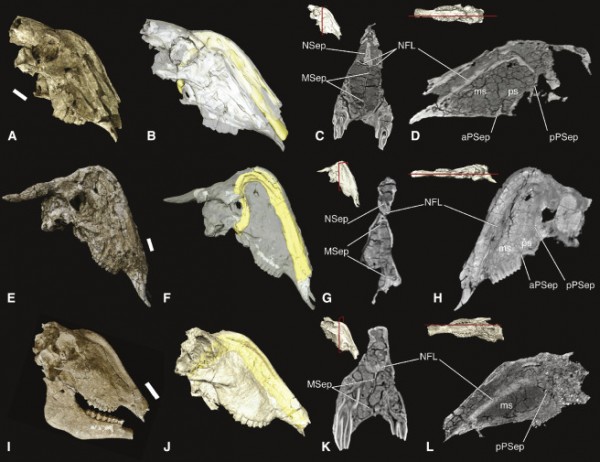By Ana Verayo, | February 07, 2016

Wildebeest-like Rusingoryx atopocranion shared this bizarre feature with hadrosaurs.
Scientists have unearthed a fossil of a creature similar to a wildebeest that also possesses a bizarre nasal structure that appear more dinosaur than mammal. In this new study, researchers examined the Rusingoryx atopocranion who has a distinct nasal cavity, discovered from an ancient steambed in Rusinga Island in Kenya.
Like Us on Facebook
Researchers describe the Rusingoryx and its weird protrusion on top of its head in this new study, where this ancient creature used to roam African savannas some tens of thousands years ago. This creature is likened to the hadrosaurs, which are duckbilled dinosaurs possessing head crests.
According to paleontologist Haley O'Brien from the Ohio University, the grass eating, hoofed creatures also produced a low sound like trumpets, in order to communicate with others from a long distance within its herd, where this hollow structure helped produce this sound.
O'Brien describes this structure as very surprising, since the discovery of a hollow nasal crest that resembles dinosaurs is newly found in a mammal who only lived recently.
These fossils measured almost the size of the modern day wildebeest that date back to 55,000 to 75,000 years. On the other hand, hadrosaurs with similar nasal features known as the Lambeosaurus and Corythosaurus, existed some 75 million years ago.
Researchers say that this nasal structure is a prime example of convergent evolution where separate organisms or species evolve similar features such as bird wings, bats and extinct flying reptiles called pterosaurs, that have adapted to similar environments and ecosystems.
Apparently, the rusingoryx and the hadrosaur both lived similar lifestyles as they are also herbivores and travel in herds.
Scientists also believe that the hadrosaurs' hollow cavity crests are also used for communicating with other members of the herd. The sound that the Rusingoryx produce is also unique, as researchers say that its nasal mechanism also allows it to make deep vocal calls that can be translated as infrasound levels so that other animal species cannot hear them.
O'Brien adds that this new frequency makes communication for them safer as vocalizations can alert predators nearby.
There were at least 24 specimens that were uncovered on the site as researchers examined six adult and juvenile Rusingoryx skulls. The nasal passages outside the hollow bony crest had an S-shaped pathway following a soft tissue part of its airway, that were located on top of large sinuses.
According to paleoanthropologist Kirsten Jenkins from the University of Minnesota, the bone remnants suggest that humans have butchered these animals with the use of stone tools where hunter gatherers led the herd to a stream to ambush them.
This new study is published in the journal, Current Biology.
-
Use of Coronavirus Pandemic Drones Raises Privacy Concerns: Drones Spread Fear, Local Officials Say

-
Coronavirus Hampers The Delivery Of Lockheed Martin F-35 Stealth Fighters For 2020

-
Instagram Speeds Up Plans to Add Account Memorialization Feature Due to COVID-19 Deaths

-
NASA: Perseverance Plans to Bring 'Mars Rock' to Earth in 2031

-
600 Dead And 3,000 In The Hospital as Iranians Believed Drinking High-Concentrations of Alcohol Can Cure The Coronavirus

-
600 Dead And 3,000 In The Hospital as Iranians Believed Drinking High-Concentrations of Alcohol Can Cure The Coronavirus

-
COVID-19: Doctors, Nurses Use Virtual Reality to Learn New Skills in Treating Coronavirus Patients







